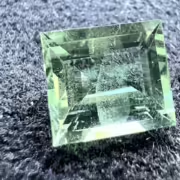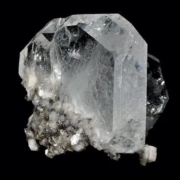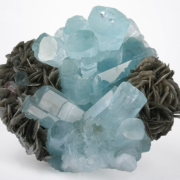Beryl stone – properties, virtues & benefits
Beryl Stone is a precious gem with a variety of colors, from emerald green to aquamarine blue. Discover its properties, virtues and uses in jewelry and lithotherapy.
BERYL CHARACTERISTICS
- Chakra: Heart, Throat.
- Properties: Harmony, Clarity, Courage.
- Astrology: Mercury.
- Zodiac: Gemini, Pisces.
- Elements: Water, Earth.
- Colors: Green, Blue, Yellow, Pink, Colorless.
- Hardness: 7.5-8.
- Chemical Formula: Be₃Al₂SiO₆.
- Associated god: Apollo.
BÉRYL – HIS STORY
Beryl stone has a long history dating back to ancient times, having been first mentioned in Pliny’s work of natural history in 77 AD. Its name comes from the Latin “beryllus”, derived from the ancient Greek “beryllos”, which literally means “color of sea water”. In ancient Rome, the stone was used to make objects such as magnifying glasses.
Nowadays, the beryl stone is best known as the main source of beryllium, a metal used to create certain alloys and in nuclear power generation. However, the crystals extracted from this mineral are still used in jewelry to create various types of jewelry such as pendants, rings and ornaments. They are prized for their ability to be cut in a multitude of ways, including drop, pear, square and facet shapes.
BERYL STONE – ITS ORIGIN AND COMPOSITION
There are several types of beryl, distinguished by their color, including emerald (green), aquamarine (blue or green-blue), heliodore (golden or yellow), goshenite (colorless), morganite (Pink to orange) and red beryl. These semi-precious or precious gems belong to the silicate group and may contain traces of various metals such as iron, manganese, magnesium, calcium, chromium or sodium, which explains the variety of their colors, which can be light or dark, transparent or opaque.
Although beryl is found worldwide, it is mined mainly in Colombia, Russia (for heliodore), Brazil (for aquamarine, heliodore and other types of beryl) and Pakistan (for aquamarine). Significant deposits are also found in the USA and France, notably at Orvault (Loire-Atlantique), La Villeder (Morbihan), Alençon (Orne), Bessines (Haute-Vienne) and Autun (Saône-et-Loire).
Beryl is the result of a crystallization phenomenon explained by the enrichment of magma with water and the addition of rare elements. It is characterized by a vitreous or matte luster, imperfect cleavage and hexagonal morphology with prismatic faces. It is fairly hard, with a density ranging from 2.60 to 2.90. Crystals can be large, thanks in particular to the mineralizing elements fluorine and boron. Beryl stone fluoresces and luminesces under ultraviolet light, revealing a white streak as well as a conchoidal fracture.
Hydrothermal synthesis of this mineral can be achieved by mixing silica, alumina and beryllium bicarbonate, with a temperature of 400°C to 850°C and a pressure of 400 to 2000 bar. Beryl can be classified into five categories according to alkali content: alkali-free, alkali-poor, sodic, sodic-lithitic and cesio-lithitic. It is an integral part of the cyclosilicates, characterized by a six-membered ring and a structure with symmetry perpendicular to the main axis, composed of silicon and aluminum atoms (or silicon and OH hydroxyls). According to Strunz’s classification, this stone belongs to group 9.CJ.05 and can be considered a silicate with a six-membered ring, or more precisely, a cyclosilicate. According to Zoltai’s classification, beryl has the topology of a tectosilicate.

BERYL STONE – VERTIES AND PROPERTIES
PHYSICAL BEERYL
Beryl is a stone that has been known since ancient times. Different types of beryl exist and are characterized by their color. These gems are mainly mined in Colombia, Russia, Brazil and Pakistan. Beryl is used in jewelry and is considered a cyclosilicate. Beryl has lithotherapeutic properties that vary according to its color and specificity. It is useful for closing gaps in the etheric body and for connecting to the higher planes. It acts as an inner guide, helPing you to step back and modify your reality according to who you are in essence.
Each variety of beryl has specific properties. Yellow or golden heliodore stimulates the mind and reduces stress, while Pink to orange morganite soothes emotional problems and improves seductive abilities. In general, this stone acts gently to purge negative energies and reduce stress. This stone’s preferred chakras are the solar plexus, heart and coronal chakra, but other chakras may be involved depending on the stone’s color and variety.
Beryls are symbols of good luck, calm and purity, and are used as wedding gifts in India. Each beryl color can have different virtues, such as boosting willpower or courage, reducing idleness, or even bringing about prophetic dreams. In addition to their lithotherapeutic properties, beryls enable the user to connect to higher planes and integrate higher thought systems. This new self-perception makes it possible to concretely modify one’s reality to bring it into line with one’s essence.
BEERYL ON THE PHYSICAL LEVEL
As previously mentioned, the physical benefits offered by Beryl stone vary according to variety and color. It is believed to play a significant role in establishing harmony between the subtle bodies. In general, the different varieties of beryl help to purify the body and stimulate breathing and blood circulation. Some may also offer specific benefits, such as stimulating the liver and bone marrow. It can also relieve various ailments such as swollen glands, arterial pain, intestinal disorders, constipation, as well as pain associated with menstruation or pregnancy. In addition, it strengthens the eyes, coronary arteries and heart.
BERYL STONE – CLEAN AND RECHARGE
To clean and recharge the Beryl Stone, follow these steps:
- Cleaning:
- Distilled water: Place the stone in a container with distilled water for a few hours. Avoid tap water, which may contain impurities.
- Fleur de vie: You can also place the stone on a Fleur de vie to cleanse it energetically.
- Reloading:
- Sunlight: Expose the stone to sunlight for a few hours, preferably in the morning or late afternoon to avoid overexposure.
- Moonlight: You can also recharge the stone under moonlight, especially during a full moon, for a softer, more feminine effect.
- Crystalline amas: place the stone on a quartz or amethyst cluster to recharge.
Don’t forget to clean and recharge your Beryl stone regularly to preserve its properties and energy.
WHERE DOES THE NAME BÉRYL COME FROM?
The name “beryl” comes from the ancient Greek “beryllos” (βήρυλλος), which referred to the various blue-green gemstones, such as aquamarine. This Greek term is itself derived from the Sanskrit “veruliyam” and the Prakrit “veruliya”. Both terms were used to describe gemstones in the beryl family, notably green beryl, now known as emerald. Thus, the name “beryl” refers to the variety of gems belonging to this mineral family.
WHICH CHAKRA DOES BERYL ACT ON?
Beryl acts primarily on two chakras depending on its color:
- Heart chakra (Anahata): Green beryl, like emerald, is associated with the heart chakra. It promotes harmony, emotional balance and stimulates compassion and unconditional love.
- Throat chakra (Vishuddha): Blue beryl, like aquamarine, is linked to the throat chakra. It facilitates communication, self-expression and boosts self-confidence.
Other varieties of beryl, such as yellow beryl (heliodore) or Pink beryl (morganite), can also have an influence on other chakras, but the two chakras mentioned above are the ones most commonly associated with beryl.
WHICH ASTROLOGICAL SIGN IS ASSOCIATED WITH BERYL?
Beryl is associated with several astrological signs, depending on its color. Here are a few examples:
- Geminians: Geminians are generally associated with beryl due to their connection with the planet Mercury. Beryl, particularly aquamarine (blue beryl), is often recommended for these natives to foster communication and self-expression.
- Fish: Beryl, particularly aquamarine, is also associated with the sign of Pisces. This stone helps Pisceans develop their intuition, sensitivity and emotional connection.
Other varieties of beryl can be linked to other astrological signs, but Gemini and Pisces are the two signs most commonly associated with beryl.
BERYL STONE SUMMARY
Beryl is a precious mineral composed mainly of aluminum silicate and beryllium. It is prized for its hardness, transparency and variety of colors, which stem from the presence of trace elements in its crystalline structure. The most notable gems formed from beryl include emerald (green) and aquamarine (blue-green).
Beryl is found mainly in granitic pegmatites and hydrothermal veins, but can also be discovered in certain metamorphic rocks. The main beryl deposits are located in Colombia, Brazil, Zambia, Zimbabwe, Afghanistan and the USA.
Beryl has been used since ancient times to create jewelry and objets d’art, due to its beauty and rarity. Today, it is still widely used in the jewelry industry, where high-quality gems are cut and polished to make rings, necklaces and earrings. Beryl is also used in certain industrial applications, such as the manufacture of optical lenses and electronic components.




